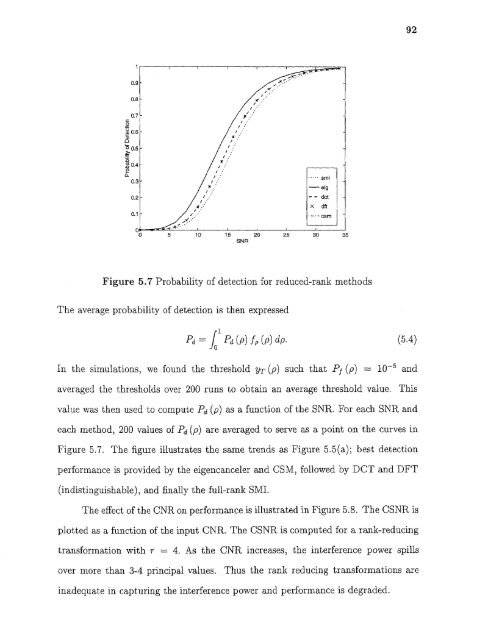Space/time/frequency methods in adaptive radar - New Jersey ...
Space/time/frequency methods in adaptive radar - New Jersey ...
Space/time/frequency methods in adaptive radar - New Jersey ...
You also want an ePaper? Increase the reach of your titles
YUMPU automatically turns print PDFs into web optimized ePapers that Google loves.
92Figure 5.7 Probability of detection for reduced-rank <strong>methods</strong>The average probability of detection is then expressedIn the simulations, we found the threshold yT (p) such that P1 (p) = 10 andaveraged the thresholds over 200 runs to obta<strong>in</strong> an average threshold value. Thisvalue was then used to compute Pd (p) as a function of the SNR. For each SNR andeach method, 200 values of Pd (p) are averaged to serve as a po<strong>in</strong>t on the curves <strong>in</strong>Figure 5.7. The figure illustrates the same trends as Figure 5.5(a); best detectionperformance is provided by the eigencanceler and CSM, followed by DCT and DFT(<strong>in</strong>dist<strong>in</strong>guishable), and f<strong>in</strong>ally the full-rank SMI.The effect of the CNR on performance is illustrated <strong>in</strong> Figure 5.8. The CSNR isplotted as a function of the <strong>in</strong>put CNR. The CSNR is computed for a rank-reduc<strong>in</strong>gtransformation with r 4. As the CNR <strong>in</strong>creases, the <strong>in</strong>terference power spillsover more than 3-4 pr<strong>in</strong>cipal values. Thus the rank reduc<strong>in</strong>g transformations are<strong>in</strong>adequate <strong>in</strong> captur<strong>in</strong>g the <strong>in</strong>terference power and performance is degraded.
















